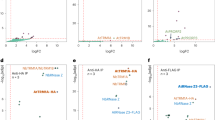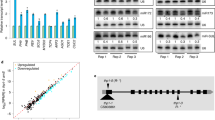Abstract
The ubiquitous endonuclease RNase P is responsible for the 5′ maturation of tRNA precursors. Until the discovery of human mitochondrial RNase P, these enzymes had typically been found to be ribonucleoproteins, the catalytic activity of which is associated with the RNA component. Here we show that, in Arabidopsis thaliana mitochondria and plastids, a single protein called 'proteinaceous RNase P' (PRORP1) can perform the endonucleolytic maturation of tRNA precursors that defines RNase P activity. In addition, PRORP1 is able to cleave tRNA-like structures involved in the maturation of plant mitochondrial mRNAs. Finally, we show that Arabidopsis PRORP1 can replace the bacterial ribonucleoprotein RNase P in Escherichia coli cells. PRORP2 and PRORP3, two paralogs of PRORP1, are both localized in the nucleus.
This is a preview of subscription content, access via your institution
Access options
Subscribe to this journal
Receive 12 print issues and online access
$189.00 per year
only $15.75 per issue
Buy this article
- Purchase on Springer Link
- Instant access to full article PDF
Prices may be subject to local taxes which are calculated during checkout





Similar content being viewed by others
References
Evans, D., Marquez, S.M. & Pace, N.R. RNase P: interface of the RNA and protein worlds. Trends Biochem. Sci. 31, 333–341 (2006).
Hartmann, R.K., Gößringer, M., Spath, B., Fischer, S. & Marchfelder, A. The making of tRNAs and more—RNase P and tRNase Z. Prog. Mol. Biol. Transl. Sci. 85, 319–368 (2009).
Walker, S.C. & Engelke, D.R. Ribonuclease P: the evolution of an ancient RNA enzyme. Crit. Rev. Biochem. Mol. Biol. 41, 77–102 (2006).
Lai, L.B., Vioque, A., Kirsebom, L.A. & Gopalan, V. Unexpected diversity of RNase P, an ancient tRNA processing enzyme: challenges and prospects. FEBS Lett. 584, 287–296 (2010).
Guerrier-Takada, C., Gardiner, K., Marsh, T., Pace, N. & Altman, S. The RNA moiety of ribonuclease P is the catalytic subunit of the enzyme. Cell 35, 849–857 (1983).
Pannucci, J.A., Haas, E.S., Hall, T.A., Harris, J.K. & Brown, J.W. RNase P RNAs from some Archaea are catalytically active. Proc. Natl. Acad. Sci. USA 96, 7803–7808 (1999).
Kikovska, E., Svard, S.G. & Kirsebom, L.A. Eukaryotic RNase P RNA mediates cleavage in the absence of protein. Proc. Natl. Acad. Sci. USA 104, 2062–2067 (2007).
Wang, M.J., Davis, N.W. & Gegenheimer, P. Novel mechanisms for maturation of chloroplast transfer RNA precursors. EMBO J. 7, 1567–1574 (1988).
Marchfelder, A. Plant mitochondrial RNase P. Mol. Biol. Rep. 22, 151–156 (1995).
Schön, A. Ribonuclease P from plant nuclei and photosynthetic organelles. Mol. Biol. Rep. 22, 139–145 (1995).
Thomas, B.C., Gao, L., Stomp, D., Li, X. & Gegenheimer, P.A. Spinach chloroplast RNase P: a putative protein enzyme. Nucleic Acids Symp. Ser. 33, 95–98 (1995).
Thomas, B.C., Li, X. & Gegenheimer, P. Chloroplast ribonuclease P does not utilize the ribozyme-type pre-tRNA cleavage mechanism. RNA 6, 545–553 (2000).
Holzmann, J. et al. RNase P without RNA: identification and functional reconstitution of the human mitochondrial tRNA processing enzyme. Cell 135, 462–474 (2008).
Lurin, C. et al. Genome-wide analysis of Arabidopsis pentatricopeptide repeat proteins reveals their essential role in organelle biogenesis. Plant Cell 16, 2089–2103 (2004).
Hartmann, E. & Hartmann, R.K. The enigma of ribonuclease P evolution. Trends Genet. 19, 561–569 (2003).
Piccinelli, P., Rosenblad, M.A. & Samuelsson, T. Identification and analysis of ribonuclease P and MRP RNA in a broad range of eukaryotes. Nucleic Acids Res. 33, 4485–4495 (2005).
Rosenblad, M.A., Lopez, M.D., Piccinelli, P. & Samuelsson, T. Inventory and analysis of the protein subunits of the ribonucleases P and MRP provides further evidence of homology between the yeast and human enzymes. Nucleic Acids Res. 34, 5145–5156 (2006).
Guerrier-Takada, C. & Altman, S. Catalytic activity of an RNA molecule prepared by transcription in vitro. Science 223, 285–286 (1984).
Rossmanith, W. & Holzmann, J. Processing mitochondrial (t)RNAs: new enzyme, old job. Cell Cycle 8, 1650–1653 (2009).
Barkan, A. Proteins encoded by a complex chloroplast transcription unit are each translated from both monocistronic and polycistronic mRNAs. EMBO J. 7, 2637–2644 (1988).
Giegé, P., Hoffmann, M., Binder, S. & Brennicke, A. RNA degradation buffers asymmetries of transcription in Arabidopsis mitochondria. EMBO Rep. 1, 164–170 (2000).
Hanic-Joyce, P.J., Spencer, D.F. & Gray, M.W. In vitro processing of transcripts containing novel tRNA-like sequences ('t-elements') encoded by wheat mitochondrial DNA. Plant Mol. Biol. 15, 551–559 (1990).
Bellaoui, M., Pelletier, G. & Budar, F. The steady-state level of mRNA from the Ogura cytoplasmic male sterility locus in Brassica cybrids is determined post-transcriptionally by its 3′ region. EMBO J. 16, 5057–5068 (1997).
Forner, J., Weber, B., Thuss, S., Wildum, S. & Binder, S. Mapping of mitochondrial mRNA termini in Arabidopsis thaliana: t-elements contribute to 5′ and 3′ end formation. Nucleic Acids Res. 35, 3676–3692 (2007).
Wegscheid, B. & Hartmann, R.K. The precursor tRNA 3′-CCA interaction with Escherichia coli RNase P RNA is essential for catalysis by RNase P in vivo. RNA 12, 2135–2148 (2006).
Srisawat, C. et al. An active precursor in assembly of yeast nuclear ribonuclease P. RNA 8, 1348–1360 (2002).
Kiss, T., Marshallsay, C. & Filipowicz, W. 7–2/MRP RNAs in plant and mammalian cells: association with higher order structures in the nucleolus. EMBO J. 11, 3737–3746 (1992).
Schmitz-Linneweber, C. & Small, I. Pentatricopeptide repeat proteins: a socket set for organelle gene expression. Trends Plant Sci. 13, 663–670 (2008).
Beick, S., Schmitz-Linneweber, C., Williams-Carrier, R., Jensen, B. & Barkan, A. The pentatricopeptide repeat protein PPR5 stabilizes a specific tRNA precursor in maize chloroplasts. Mol. Cell. Biol. 28, 5337–5347 (2008).
Dupureur, C.M. Roles of metal ions in nucleases. Curr. Opin. Chem. Biol. 12, 250–255 (2008).
Steitz, T.A. & Steitz, J.A. A general two-metal-ion mechanism for catalytic RNA. Proc. Natl. Acad. Sci. USA 90, 6498–6502 (1993).
Helm, M. et al. Search for characteristic structural features of mammalian mitochondrial tRNAs. RNA 6, 1356–1379 (2000).
Florentz, C., Sohm, B., Tryoen-Toth, P., Putz, J. & Sissler, M. Human mitochondrial tRNAs in health and disease. Cell. Mol. Life Sci. 60, 1356–1375 (2003).
Vogel, J. & Hess, W.R. Complete 5′ and 3′ end maturation of group II intron-containing tRNA precursors. RNA 7, 285–292 (2001).
Kirsebom, L.A. RNase P RNA mediated cleavage: substrate recognition and catalysis. Biochimie 89, 1183–1194 (2007).
Holzmann, J. & Rossmanith, W. tRNA recognition, processing, and disease: hypotheses around an unorthodox type of RNase P in human mitochondria. Mitochondrion 9, 284–288 (2009).
Dereeper, A. et al. Phylogeny.fr: robust phylogenetic analysis for the non-specialist. Nucleic Acids Res. 36, W465–W469 (2008).
Edgar, R.C. MUSCLE: a multiple sequence alignment method with reduced time and space complexity. BMC Bioinformatics 5, 113 (2004).
Gascuel, O. BIONJ: an improved version of the NJ algorithm based on a simple model of sequence data. Mol. Biol. Evol. 14, 685–695 (1997).
Chevenet, F., Brun, C., Banuls, A.L., Jacq, B. & Christen, R. TreeDyn: towards dynamic graphics and annotations for analyses of trees. BMC Bioinformatics 7, 439 (2006).
Gleave, A.P. A versatile binary vector system with a T-DNA organisational structure conducive to efficient integration of cloned DNA into the plant genome. Plant Mol. Biol. 20, 1203–1207 (1992).
Abel, S. & Theologis, A. Transient transformation of Arabidopsis leaf protoplasts: a versatile experimental system to study gene expression. Plant J. 5, 421–427 (1994).
Giegé, P., Sweetlove, L. & Leaver, C. Identification of mitochondrial protein complexes in Arabidopsis using two-dimensional Blue-Native polyacrylamide gel electrophoresis. Plant Mol. Biol. Rep. 21, 133–144 (2003).
Uyttewaal, M. et al. PPR336 is associated with polysomes in plant mitochondria. J. Mol. Biol. 375, 626–636 (2008).
Rayapuram, N., Hagenmuller, J., Grienenberger, J.M., Bonnard, G. & Giegé, P. The three mitochondrial encoded CcmF proteins form a complex that interacts with CCMH and c-type apocytochromes in Arabidopsis. J. Biol. Chem. 283, 25200–25208 (2008).
Lamattina, L., Gonzalez, D., Gualberto, J. & Grienenberger, J.M. Higher plant mitochondria encode an homologue of the nuclear-encoded 30-kDa subunit of bovine mitochondrial complex I. Eur. J. Biochem. 217, 831–838 (1993).
Meyer, E.H. et al. AtCCMH, an essential component of the c-type cytochrome maturation pathway in Arabidopsis mitochondria, interacts with apocytochrome c. Proc. Natl. Acad. Sci. USA 102, 16113–16118 (2005).
Rossmanith, W., Tullo, A., Potuschak, T., Karwan, R. & Sbisa, E. Human mitochondrial tRNA processing. J. Biol. Chem. 270, 12885–12891 (1995).
Cruz-Reyes, J., Piller, K.J., Rusche, L.N., Mukherjee, M. & Sollner-Webb, B. Unexpected electrophoretic migration of RNA with different 3′ termini causes a RNA sizing ambiguity that can be resolved using nuclease P1-generated sequencing ladders. Biochemistry 37, 6059–6064 (1998).
Stragier, P., Bonamy, C. & Karmazyn-Campelli, C. Processing of a sporulation σ factor in Bacillus subtilis: how morphological structure could control gene expression. Cell 52, 697–704 (1988).
Gößringer, M. & Hartmann, R.K. Function of heterologous and truncated RNase P proteins in Bacillus subtilis. Mol. Microbiol. 66, 801–813 (2007).
Gößringer, M., Kretschmer-Kazemi Far, R. & Hartmann, R.K. Analysis of RNase P protein (rnpA) expression in Bacillus subtilis utilizing strains with suppressible rnpA expression. J. Bacteriol. 188, 6816–6823 (2006).
Acknowledgements
We thank T. Potuschak for critical reading of the manuscript. This work was supported by the Centre National de la Recherche Scientifique, by research grant 07-JCJC-0123 from the Agence Nationale de la Recherche (ANR) to P.G., by grants P17453 and I299 from the Austrian Science Fund (FWF) to W.R. and by grant HA-1672/7-5/14-3 from the Deutsche Forschungsgemeinschaft (DFG) to R.K.H.
Author information
Authors and Affiliations
Contributions
A.G., R.K.H., J.H., W.R. and P.G. conceived and designed the experiments; A.G., B.G., A.T., M.G. and P.G. performed the experiments; A.G., B.G., A.T., M.G., R.K.H., W.R. and P.G. analyzed the data; A.G., R.K.H., W.R. and P.G. wrote the paper.
Corresponding authors
Ethics declarations
Competing interests
The authors declare no competing financial interests.
Supplementary information
Supplementary Text and Figures
Supplementary Figures 1–6 and Supplementary Tables 1 and 2 (PDF 2856 kb)
Rights and permissions
About this article
Cite this article
Gobert, A., Gutmann, B., Taschner, A. et al. A single Arabidopsis organellar protein has RNase P activity. Nat Struct Mol Biol 17, 740–744 (2010). https://doi.org/10.1038/nsmb.1812
Received:
Accepted:
Published:
Issue Date:
DOI: https://doi.org/10.1038/nsmb.1812
This article is cited by
-
Importance of residue 248 in Escherichia coli RNase P RNA mediated cleavage
Scientific Reports (2023)
-
Crystal structures and insights into precursor tRNA 5’-end processing by prokaryotic minimal protein-only RNase P
Nature Communications (2022)
-
Towards plant resistance to viruses using protein-only RNase P
Nature Communications (2021)
-
Ccm1p is a 15S rRNA primary transcript processing factor as elucidated by a novel in vivo system in Saccharomyces cerevisiae
Current Genetics (2020)
-
Targeted cleavage of nad6 mRNA induced by a modified pentatricopeptide repeat protein in plant mitochondria
Communications Biology (2018)



